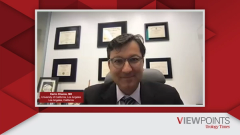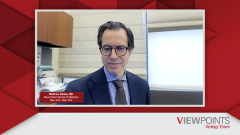
Active Surveillance in Muscle Invasive Bladder Cancer
Types of patients with muscle invasive bladder cancer who may be candidates for a watch-and-wait approach.
Episodes in this series

Leonard G. Gomella, MD: Matt, maybe you can comment a little. Do you think there’s any role for watching and waiting some patients with muscle invasive disease? There are some that you just treat conservatively without giving any aggressive therapy. Is there any role for that with muscle invasive disease?
Matthew Galsky, MD: There are 2 populations of patients for whom that approach is traditionally considered. In 1 group of patients who have comorbidities, any radical approaches the risks might outweigh the potential benefits. I don’t think that’s a large population, but once in a while you see patients for whom that might be the best approach. Of course, there’s the flip side: patients have tumor biology sufficiently indolent or responsive to treatment, so maximal TURBT [transurethral resection of bladder tumor] plus or minus systemic therapy might be definitive treatment for muscle-invasive bladder cancer. This was a hot area a couple of decades ago with the advent of cisplatin-based combination chemotherapy and the responsiveness of tumors, asking the question, “Can surgery be avoided?” It went out of favor, and now it’s back.
It’s back for a couple reasons. One is we have biomarkers that might help inform which patients might do best with that approach. The other is the drugs are getting better, so there are a higher proportion of patients who might achieve those good responses. There are a number of clinical trials in phase 2 testing that concept that recently completed. Some larger studies are ongoing. We’ll have more data about whether this is a feasible approach for select subgroups of patients within the next few years.
Leonard G. Gomella, MD: Karim, any watch-and-wait approaches if somebody isn’t responding to intravesical therapy with nonmuscle-invasive disease? Is there any role for watching them and periodically resecting them? How would you approach that with watch and wait?
Karim Chamie, MD: I obviously offer it to patients who have low-grade first-onset noninvasive small-volume bladder cancer. I resect them, then I watch and wait. For patients who have low-grade and late recurrences, I offer the same approach. For patients who have higher-risk features but have significant lower urinary tract toxicities—frequency, urgency, and they’re unable to maintain the drugs of choice—those are the ones who I endoscopically ablate in the office or in the operating room without torturing their bladder with some of these intravesical therapies. That’s something that we have to balance because we can’t overinstill for these patients. The last thing we want is an end-stage bladder [cancer], when we have to do a radical cystectomy on someone who didn’t need it.
Leonard G. Gomella, MD: Yes, that’s a good point. You have to personalize, so each patient has to be looked at as a unique individual considering many aspects.
Transcript edited for clarity.
Newsletter
Stay current with the latest urology news and practice-changing insights — sign up now for the essential updates every urologist needs.




















